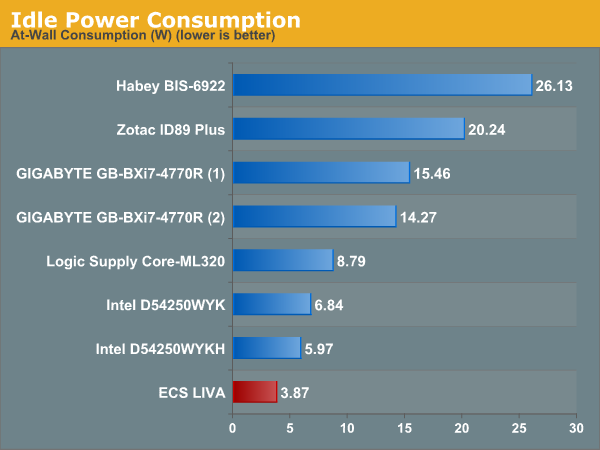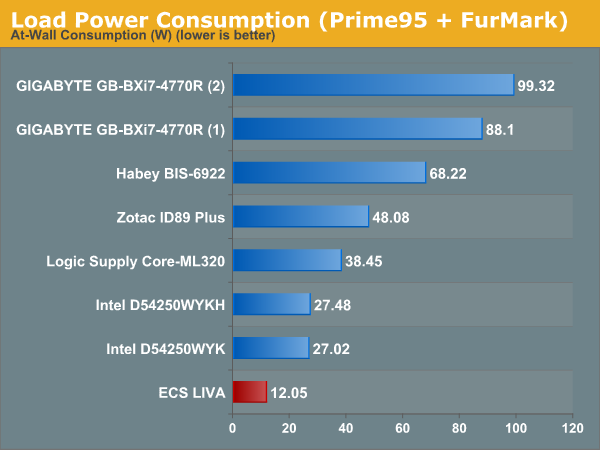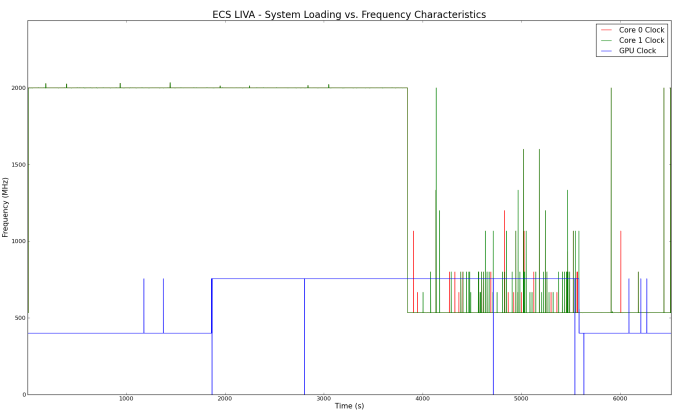ECS LIVA Review: The Nettop Rises Again
by Ganesh T S on July 18, 2014 9:15 AM ESTPower Consumption and Thermal Performance
The power consumption at the wall was measured with the display being driven through the HDMI port. In the graphs below, we compare the idle and load power of the ECS LIVA with other low power PCs evaluated before. For load power consumption, we ran Furmark 1.12.0 and Prime95 v27.9 together.


In order to evaluate thermal performance, we first ran our test for load power consumption and made sure that the unit wasn't getting throttled. In order to determine the efficiency of the cooling system, we first loaded up the CPU alone using just Prime 95 for around 30 minutes. This was followed by addition of the GPU load (FurMark) for another 30 minutes, and then removal of the CPU load for 10 minutes. The system was then left idle. The various frequencies and temperatures during this loading process are recorded in the graphs below.
The above graphs show that ECS has designed a 25% overclock into the Celeron N2806, operating it at 2.00 GHz throughout our CPU loading test (with and without the GPU loading). The GPU is also able to sustain the maximum dynamic frequency of 750 MHz+ without thermal issues. At idle, the cores drop down close to 500 MHz and the GPU drops down to around 350 MHz. On the temperature side, we see the temperature stabilizing at slightly less than 100 C. With a junction temperature of 105 C, I believe consumers don't need to worry about thermal throttling at usual room temperatures (~78 F was the ambient when we tested) irrespective of the load on the unit.












55 Comments
View All Comments
eastcoast_pete - Saturday, July 19, 2014 - link
I second the comments regarding netbooks made here. Trying to do some actual writing on touch screens is a pain, even on larger tablets. I considered Chromebooks , but Google's "required tethering" approach doesn't work for me. I'd love to see MS helping to push a bunch of "Chromebook killers" into the market - Windows netbooks in the $180 - $ 300 price range with the new Baytrail Celerons, 3 or 4 Gb RAM, a 10" -12" high-res screen (no-touch), USB 3 port(s), micro-SXDC slot, and either 64 Gb eMMC 5.0 (lower price point) or 128 Gb SSD (higher). This nettop shows that it could be done. Now, if only MS would see the opportunity and seize it!esgreat - Sunday, July 20, 2014 - link
With max power around 12W and idle power around 4W, I guess I could run this thing at nominal speed with a power bank!Laststop311 - Sunday, July 20, 2014 - link
I personally would rather pay the 800 for the i7-4770r brix system. It must be rough to not have enough money to get the things u want. I don't know how to compromise so news about these systems heavily bores me.AmericanIdle - Friday, August 15, 2014 - link
You were so bored by this story that you felt inspired to leave a comment?The Brix is not fanless, and thus not silent. Also, it uses about 10 times as much power, which matters if you care about the future of the planet. It must be rough to know the price of everything and the value of nothing. I hope you learn how to compromise someday!
Haravikk - Thursday, July 24, 2014 - link
I don't really see the appeal of going so small with so many sacrifices personally, I mean Thin Mini-ITX cases like the Akasa Euler are still tiny machines (about Mac Mini size but a bit taller) and you can put proper desktop processors in them! You can even build a basic dual core system at a very reasonable price. This is why I never liked the idea of a Netbook; they never saved enough money to justify their horrific performance IMO, even when used for nothing but browsing (especially with the increasing demands of modern web content).